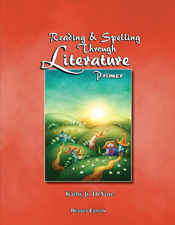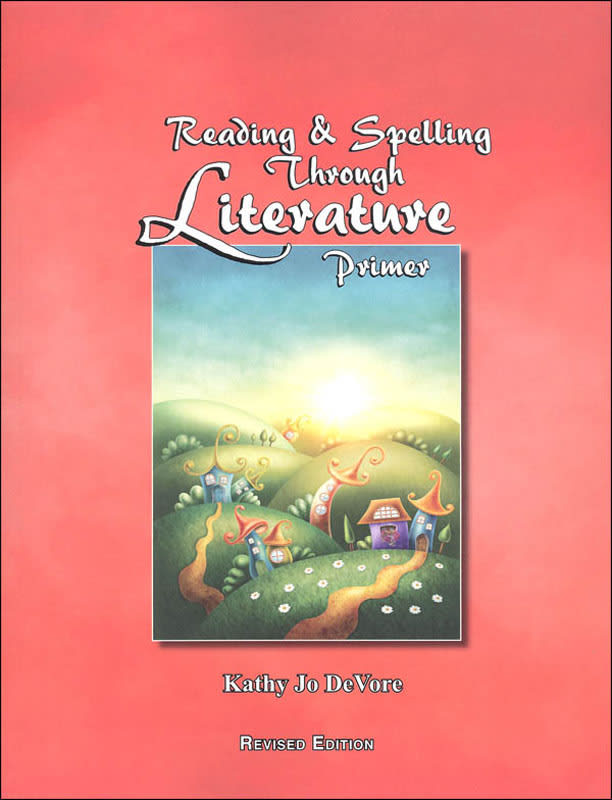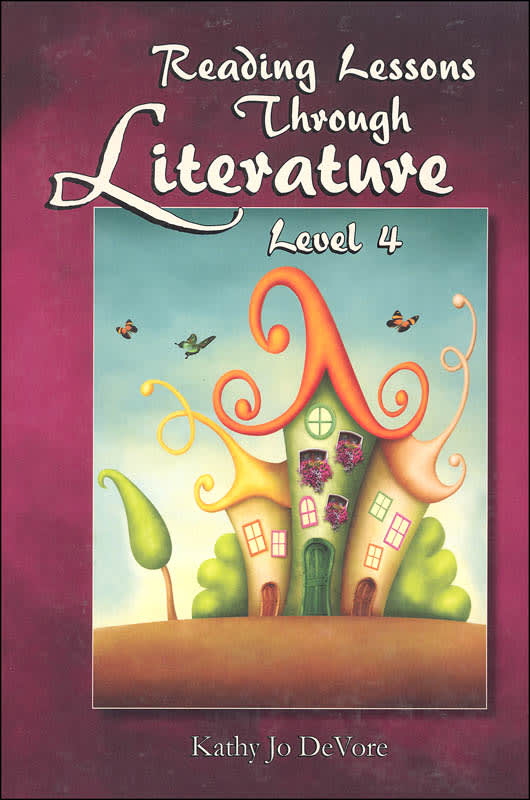The Reading & Spelling Through Literature (RSTL) series uses Orton-Gillingham methodology to teach reading for kindergarten through third grade. Children need no prior knowledge of letters and sounds. This is a complete, self-contained program in four volumes: Primer, Level 2, Level 3, and Level 4.
The program teaches 75 phonograms and 30 spelling rules. When it teaches a phonogram, it teaches all of the sounds for that phonogram. Children learn a system for marking the phonograms that helps them recall the sounds and the rules. So, for example, students learn both the hard and soft sounds for the letter “c” in the same lesson, and they learn the various sounds for each vowel all together when each vowel is introduced. Initial lessons identify phonograms by sounds rather than the names of the letters. Children learn to both read and write the phonograms from the very beginning.
The Orton-Gillingham approach applies phonetic rules to words that other programs treat as sight words. Consequently, within the 1,720 words in the spelling lists in the first three levels, there are fewer than ten words that are marked as being exceptions to the rules (sight words). The entire list of spelling words for all four levels of the program is included within each book along with numbers to indicate at which level they are taught.
One goal of author Kathy Jo DeVore is to make the Orton-Gillingham methodology easy for parents to teach without requiring training or classes. To that end, everything is contained in one book for each level, including the Elson Readers, which are in the public domain. Teaching information is relatively brief compared with other Orton-Gillingham programs.
Like many other Orton-Gillingham programs, RSTL covers phonics, reading, and spelling up through middle school levels.
The program has four levels that ideally fit kindergarten through third grade. However, students beyond kindergarten who still need a strong phonics foundation can begin the program and should start with the first book, subtitled Primer. The stories from the readers are the only thing that limits the program’s suitability to children in the primary grades.
By the end of Level 3, students should be able to decode most words that follow the phonetic rules. You can certainly continue with Level 4, although formal instruction of this sort on a daily basis should not be needed for most students once they have completed Level 3.
The book for each level has the same format. Books are arranged into three main sections with introductory information added at the beginning and helpful extras at the end. The three core sections are phonograms, spelling lists, and readers.
While there is concentrated instruction on the phonograms in the early lessons, phonograms are continually reviewed throughout the program. Since the phonograms are presented in very large fonts, one per page, you can easily review them from the book. But it might be easier to create a set of flashcards from the free downloadable file at DeVore’s website.
As students learn the phonograms, they practice writing or tracing them in the air, on sandpaper letters, in a sandbox, on paper, or in any other fashion that works. A sample page shows how you might set up notebook pages for a student to practice writing the phonograms. The Italic writing style is taught in the book, but you can easily substitute a different style.
Spelling is introduced once the phonograms have been taught. When you present the spelling words, the process reinforces knowledge of the phonograms while also teaching the spelling rules. Students create their own spelling notebooks. Once children have learned to recognize the sounds of the phonograms and how to write them, they begin to write spelling words by dictation, with the phonograms dictated individually. Kindergartners will have 10 to 15 new words each week to write and learn. First graders learn 20 words per week while second graders learn from 40 to 50 words per week. Third graders learn an additional 690 words over the course of the year. Words in the lists are drawn from the most-commonly-used words as shown on the Ayres List as well as from the vocabulary used in the Elson Readers. (By the end of Level 4, all words from the Ayers list have been taught.)
In Primer, the spelling lists are numbered 1-A through 1-T for the first 200 words. After that, the lists in the first book are numbered 2 through 29 with each number corresponding to the number of a story from the Elson Primer. Stories from the Primer are to be introduced after the child has been taught the first 200 spelling words. The stories will reinforce what the child has learned and quickly transition the child into meaningful reading. Since students learn to read and write 200 words before beginning to read stories, the vocabulary in the first story is more complex than in programs that present simple stories to read while simultaneously teaching phonics--stories that start out like, “Pat sat on a mat.” Instead, the first story in the Elson Primer begins, “ Al-ice said, “Come, cat. Come to din-ner.” The cat said, “No. We will find a din-ner.”
The Elson Readers are reprinted in the Reading Lessons Through Literature books but with words divided into syllables as shown in the last paragraph. The Primer also has some phonograms underlined as shown to make it easier for children to spot them. Some of the language had been updated to current usage. Only one image per story was retained from the original readers to avoid pictorial prompts that might cause students to guess rather than sound out words. Elson Readers feature traditional stories (e.g., life on a farm, stories about pets), folk tales, fables, nature stories, and poetry.
Levels 2, 3, and 4 are identical to Primer (aside from page numbering) until the end of the introductory material for the second section on the spelling lists. At this point, they add information about base words, prefixes, and suffixes since these will be taught the next few years. Then each volume begins to teach with the next group of spelling lists. The words become longer and more challenging. As with Primer, the spelling lists correlate with the stories. The stories in Level 2 are drawn from Elson Book 1. Stories in Level 3 are drawn from Elson Book 2. Level 4 has stories from Elson Book 3. By the end of Level 4, students are reading passages such as, "He was no longer gray and ugly; he was a beautiful swan, with shining feathers as white as snow!" (p. 419).
An older child starting into the program might move through lessons more quickly than a younger child. So various scheduling options are included depending upon how old the child is when you start the program.
The program has an optional Handwriting Lessons Through Literature book that teaches handwriting by having students practice with phonograms, chunks of words, and material from Webster's Syllabary. New copywork books will soon be available that use the material from the Elson Readers. The copywork books should be used after Handwriting Lessons. When ordering the handwriting book and copywork books, you can choose from many options as far as the style of handwriting.
Reading & Spelling Through Literature is a very reasonably-priced program, especially since you need not purchase any extras like flashcards or readers. Parents can read through the introductory information and be ready to teach within a very short time. Most parents should be able to teach through the lessons with minimal—and maybe even no—advance preparation. All of this makes Reading & Spelling Through Literature a practical choice for those who want to teach reading using Orton-Gillingham methods.
Books are available in either print or digital editions. Click here for a free downloadable sample.














